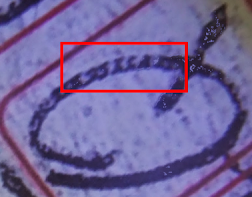Micro written message in symbol code
beneath a WW1
Dutch postage stamp contained a 1600 word intelligence report.
 |
| The actual size of this stamp was approximately 30 mm X 34 mm |
 |
| Magnified image, please note whilst the base image is as found, I have added colouration to the stamp to reflect the actual appearance. |
One of the many people recruited by this section was Louise de Bettignies who formed the highly successful 'Alice Network'. Louise recruited some very special people including the man who prepared this coded micro written message, a Paul Bernard, Belgian Map Maker, The code translated to a 1600 word intelligence report and is believed to have warned the British of the locations of a number of German gun emplacements. As a result these locations were themselves bombarded.
A Harkness Connection
Another valued member of Louise's team was Marie-Leonie Van Houtte. There is a lengthy story of the exploits of Louise and Leonie and we will be discussing that further in posts to follow. For now though the focus is on the use of Micro Writing by the British MI C section and the link via Leonie to her great niece, Marie-Ann Harkness who lives in the US. The surname could be coincidence of course, it is her married name and at this time little is known of her husbands connections. I should also say that I have attempted to contact Marie without success to date, I am hoping that someone may know of her and her family if to do nothing more than to discount any connection to the relatives of Jestyn. I gratefully acknowledge the input and assistance of Byron in the initial investigation stages.
Back to the postage stamp, the size of the letters is around .5 mm and as you can see the writer was able to pack a significant number of them behind the postage stamp. Until the rediscovery of this stamp it was thought that clandestine messages were actually written on the back of the stamp however there is a good reason why that shouldn't be the case and it relates to the issue of ink types and the nature of adhesive on the stamp itself as well as the size of the letters. The 'glue' on the stamp would have formed ridges and whilst it would be possible to write larger letters, 1.5 to 2 mm in height, directly on to the stamp, writing at the micro letter level would have presented difficulties.
What does the code that has been written on the stamp actually mean? Thanks to input from Nick Pelling of Cypher Mysteries, we now that this is a simple 'PIGPEN' code comprised of symbols and each symbol equates to a letter of the alphabet. Referring back to the source documents, it is known that the Alice Network were particularly efficient at their work and were in the habit of adding another level of encryption to their codes. If that is the case here, then the letters that result from decoding the above stamp message could belong to another cipher, Playfair or Vigenere were in use at that time.
So, how would you go about decoding what lies beneath the stamp? Below is the key and an example for you to follow:
 |
| KEY TO CODE |
 |
| EXAMPLE Reads: TEN US TRANSPORTS AT SEA |
In our research we uncovered many other examples of Micro Writing used by MI6 and its predecessors, below is one example complete with another concealment method:
 |
| Micro Written Intelligence Report |
 |
| Micro Message Concealed in a Pen. |
It must surely follow that if these incredibly smart people back in WW1 could do what they did with micro writing, encoding and concealment, and there is a lot more to come on that topic, it would be a very short step indeed to have them conceal their writing within larger letters as per the Somerton Man Code.
Who knows, maybe we will post an example of that in the near future.







Not to be excessively picky, but that is not what the coded example actually reads... Those US transports appear to be TAN.
ReplyDeleteWondered whether anyone spot it! But point taken and I will modify that. It was exactly as found in a 1935 book, in some ways it reflects the way that agents operated in the field, mistakes were made in encoding messages and they could have been costly.
DeleteLeo Marks of SOE fame talked of noticing an irregularity in coded messages coming from agents in Holland. The 'irregularity' as he put it was that the messages were perfect, no mistakes at all, whereas in messages from other areas it was common to pick up errors and mistakes. If you can imagine the stress and pressure on agents when they were writing messages it isn't hard to envisage how errors could be made.
Anyway, Marks thought that the reason the messages were perfect was because there was not stressful environment, such as you might find in an enemy radio traffic intercept room. In other words the agents had been captured but the Germans continued to send their messages. Marks came up with a brilliantly simple plan, he had noticed in many enemy messages from Abwher sources, the radio operator would sign off with HH for Heil Hitler. The response from the recipient was similar. So, when the next suspect message was received Markls had his radio operator sign off with HH in response. Sure enough, the reply came back HH